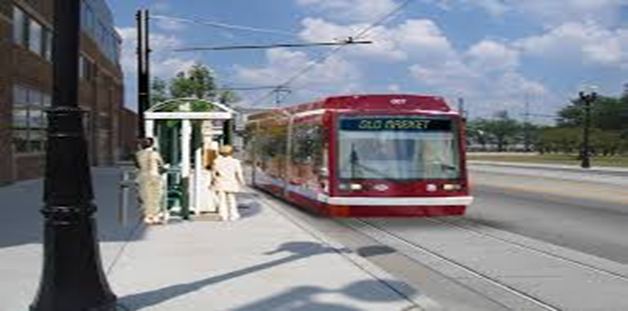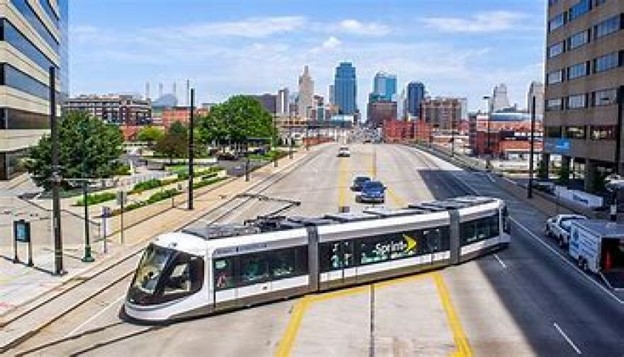
Caption: This is one concept of a modern streetcar, as envisioned by the Omaha City Planning Department.
Source: Credit to Omaha City Planning Department
| Project Name | Omaha Modern Streetcars, Nebraska |
|---|---|
| Location | Omaha, Nebraska |
| Project Sponsor / Borrower | City of Omaha, Streetcar Authority, and the Metro Transit |
| Program Areas |
|
| Value Capture Techniques | Tax Increment Financing (TIF), Transportation Corporation, Revenue Bonds, and Private Placement Bonds |
| Mode | Total Mobility System |
| Description | City of Omaha is taking an important step toward a strong and sustainable future by plans for a Total Mobility System in the urban core. A Total Mobility System is where parking is convenient and efficient, the transit system provides quick connections, and all other modes of transportation work in unison. A modern streetcar is key to this system because it allows them to use vacant parking, which helps reduce the need and cost of expensive new parking garages. That means more people can navigate downtown and midtown without bringing more cars, and it sparks the kind of development that can transform Omaha city into the bustling, innovative, vibrant place. Unlike other forms of transit, the permanency of fixed-rail streetcars ignites significant economic development and an increased tax base that strengthens city cores. Streetcars are simple to understand, attract foot traffic, which brings more life, vibrancy and retail activity to urban neighborhoods. The route concept for Omaha’s future streetcar system was approved Monday after a change was made at the eastern end of the route in downtown Omaha. The Omaha Streetcar Authority voted to approve a route concept that would see streetcars run east along Harney Street and then turn north along 10th Street up to about Cass Street near the CHI Health Center. The streetcars then would head back south on 10th to Capitol Avenue. The route would run a couple of blocks east to Eighth Street near the city’s riverfront before turning west onto Farnam Street. The cars then would travel to the route’s western terminus at 42nd Street near the University of Nebraska Medical Center. As proposed, the streetcar system would have 6.16 miles of track, but a round trip would be about 3.1 miles. City documents show that it would take about 30 minutes for a streetcar to complete the route. The streetcar will be free for all riders. The physical components of the streetcar (tracks, vehicles, maintenance facility, etc.) will be owned by the City of Omaha. It will be operated by a newly created Streetcar Authority, a public entity created through an interlocal agreement between the City of Omaha and Metro Transit. The Omaha Planning Board has approved two initial and important steps for the development of the modern streetcar and Mutual of Omaha's planned downtown headquarters. The Urban Core Housing and Mobility Redevelopment Plan focuses on three significant areas: transit and mobility improvements, affordable housing, and job growth. A Tax Increment Financing (TIF) District was created along and within three blocks of the streetcar route while TIF on new developments and existing projects already within the district will fund the construction costs. All TIF proceeds generated in the district will be spent on public improvements. Projections show the revenue generated within the TIF district will exceed the estimated construction and financing costs by at least $30 million. The additional revenue may be used for other improvements to the urban core including affordable housing, one-way/two-way street conversions, bikeways, and pedestrian improvements. The City will use a combination of Revenue Bonds, Private Placement Bonds, and philanthropic funds for construction costs. "Revenue Bonds and Private Placement Bonds are placed with buyers who assume the risk, the risk is not on the taxpayers," said City of Omaha Finance Director Steve Curtiss. "There is a strong market for these types of bonds." The bonds will pay the immediate construction costs while the TIF proceeds generated over 15-20 years will be used to pay the bonds. Annual costs to operate and maintain the streetcar system are estimated at $6.4 million, paid by the City's Parking and Mobility Division Enterprise Fund, which generates revenue from parking fees in garages and meters. |
| Cost | $356 million |
| Funding Sources | Tax Increment Revenue |
| Project Delivery / Contract Method | Transportation Corporation/Streetcar Authority |
| Private Partner | TBD |
| Project Advisors / Consultants | HDR completed a Financial Assessment that provided information related to funding options for a Modern Streetcar |
| Lenders | Bondholders |
| Duration / Status |
Design work on the Omaha streetcar is underway. A timeline presented to the Omaha Streetcar Authority this week anticipates construction will begin in 2024 and the streetcar can be operating in 2026. The initial design work is focused on the streetcar route, utility coordination, the streetcar vehicle maintenance facility, and vehicle specifications. |
| Financial Status / Financial Performance | A Tax Increment Financing (TIF) District created along and within three blocks of the streetcar route, TIF on new developments and existing projects already within the district will fund the construction costs. All TIF proceeds generated in the district will be spent on public improvements. |
| Innovations |
|
| Related Links / Articles |
|
| Contacts | Jay Noddle, President of the Streetcar Authority Robert G. Stubbe, Public Works Director at City of Omaha |

Caption: Proposed Omaha's streetcar system
Source: Credit to HDR Inc.

Caption: Omaha Modern Streetcar spur Economic Development and Improved Urban Living. The city plans to have the streetcar system operational in four years
Source: HDR Inc.